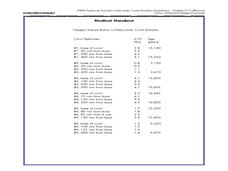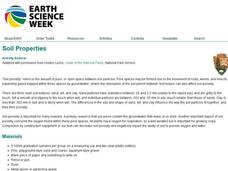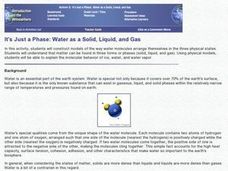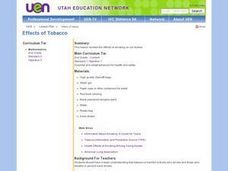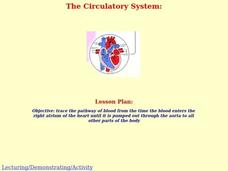Curated OER
Periods and Groups; Valence Electrons; Masses
In this periods, groups, valence electrons and masses worksheet, students are given information about all these components of the periodic table. Students identify 4 elements in specific periods and groups, they find the valence...
Curated OER
Classifying Chemical Reactions
In this chemical reactions learning exercise, students learn about the 5 types of chemical reactions as well as endothermic and exothermic reactions. Students are given 5 equations to balance and they identify the type of reaction for...
Curated OER
The Atom
In this atom worksheet, students read about the structure of the atom including its subatomic particles and John Dalton's theory of the atom. Students also read about the differences between atoms, molecules and compounds. They answer 30...
Curated OER
Elements and Bonding Worksheet
In this elements and bonding worksheet, students classify given elements, they identify valence electrons in atoms, they explain the reactivity of elements, and they explain why certain atoms gain electrons while others lose electrons.
Curated OER
Chemical Reaction Rates
High schoolers observe demonstrations to show factors that affect rates of chemical reactions. For this rates of chemical reactions lesson, students investigate how catalysts, reactant concentrations, temperature and surface area affect...
Curated OER
Making Connections-Review Experimental Design and Homeostasis
In this experimental design and homeostasis worksheet, students complete 20 sentences with key terms about designing experiments, gathering data, graphing data and determining controls. They also complete sentences about homeostasis and...
Curated OER
How can deep-water corals be used to determine long-term patterns of climate change?
Students explore the concept of paleoclimatological proxies. In this paleoclimatological proxies lesson plan, students explain isotope ratios in deep water coral samples. Students write a paragraph about global climate change as it...
Curated OER
Soil Properties
Students explore the porosity of soil. In this soil instructional activity, students conduct an experiment which shows the porosity of different types of soil. They use sand, silt, and clay to see how soil particles are more or less...
Curated OER
Model Rockets
Students build a model rocket. In this model rocket lesson, students explore a rocket launch cycle. Students investigate the laws of physics for each part of the launch. Students build model rockets and launch at school.
Curated OER
Rusting-A Form of Oxidation
Young scholars conduct an experiment to observe oxidation. In this chemistry lesson, students explain how rusting happens. They rank metals according to their conductivity.
Curated OER
The Wonders of Bacteria
Learners explore the evolution and features of bacteria through a series of activities. In this biology lesson, students collect data and graph bacterial growth. They design a brochure about bacteria's role in society.
Curated OER
Ins and Outs of Respiration
Students determine their respiratory rate and explore the factors that affect breathing rate.
Curated OER
Earth Day
Students participate in activities that familiarize them with what Earth Day is, why it is important, and why it is a celebration.
Curated OER
Food Poisoning
Identify strategies that prevent food-borne illnesses and contamination. National Standard 14.4.1 Identify food-borne illness Identify types of food-borne illness and their symptoms: botulism, e-coli, hepatitis, salmonella, staphylococci...
Curated OER
It's Just a Phase: Water as Solid, Liquid and Gas
Students construct models of the way water molecules arrange themselves in three physical states - solid, liquid, and gas. They explain the molecular behavior of ice, water, and water vapor.
Curated OER
Inter-State Matters
Students explore the six phase transitions between gases, liquids and solids for a variety of elements. Each group of students focuses on a different element, investigating its physical properties during each of the six phase transitions.
Curated OER
What's the Matter? (Experiments)
Students observe a scientific discrepant event, and are then challenged to create experiments to solve the dilemma.
Curated OER
Asthma
Students experience what it feels like to strain for air in order to empathize with people who have asthma. They create a simple model of the respiratory system to measure the effect of narrowed airway channels.
Curated OER
Healthy Heart
Young scholars explore how the heart works, examine pictures of a troubled heart, and discuss how to keep the heart healthy.
Curated OER
Teaching about the Effect of pH on Aquatic Organisms
Students perform experiments to determine the PH, acidity, and buffering qualities of a lake that make them sensitive to acid deposition.
Curated OER
It's All About the Roots
Students investigate the process of hydroponic agriculture. They grow beans in different hydroponic solutions, compare results and graph their observations.
Curated OER
Chemicals, Chemicals, Everywhere
Students divide substances into categories: made of chemicals/not made of chemicals, synthetic/naturally occurring, and toxic/nontoxic. They observe a mystery chemical and determine what precautions they need to take when handling an...
Curated OER
The Circulatory System
Students follow the path of blood from its entrance into the right atrium of the heart until it leave through the aorta to the rest of the body. They study the heart's structure and how it pumps blood using the included activities. They...
Other popular searches
- Carbon Dioxide Oxygen Cycle
- Dissolved Oxygen
- Oxygen and the Human Body
- Oxygen Cycle
- Oxygen and Carbon Dioxide
- Carbon Oxygen Cycle
- Oxygen Carbon Dioxide
- Oxygen Cycle Diagram
- Solubility Oxygen
- Mount Everest Without Oxygen
- Plants and Oxygen
- Transporting Oxygen, Glucose








